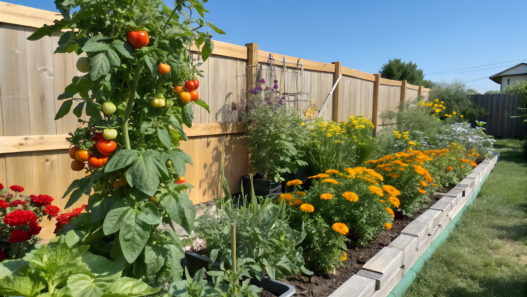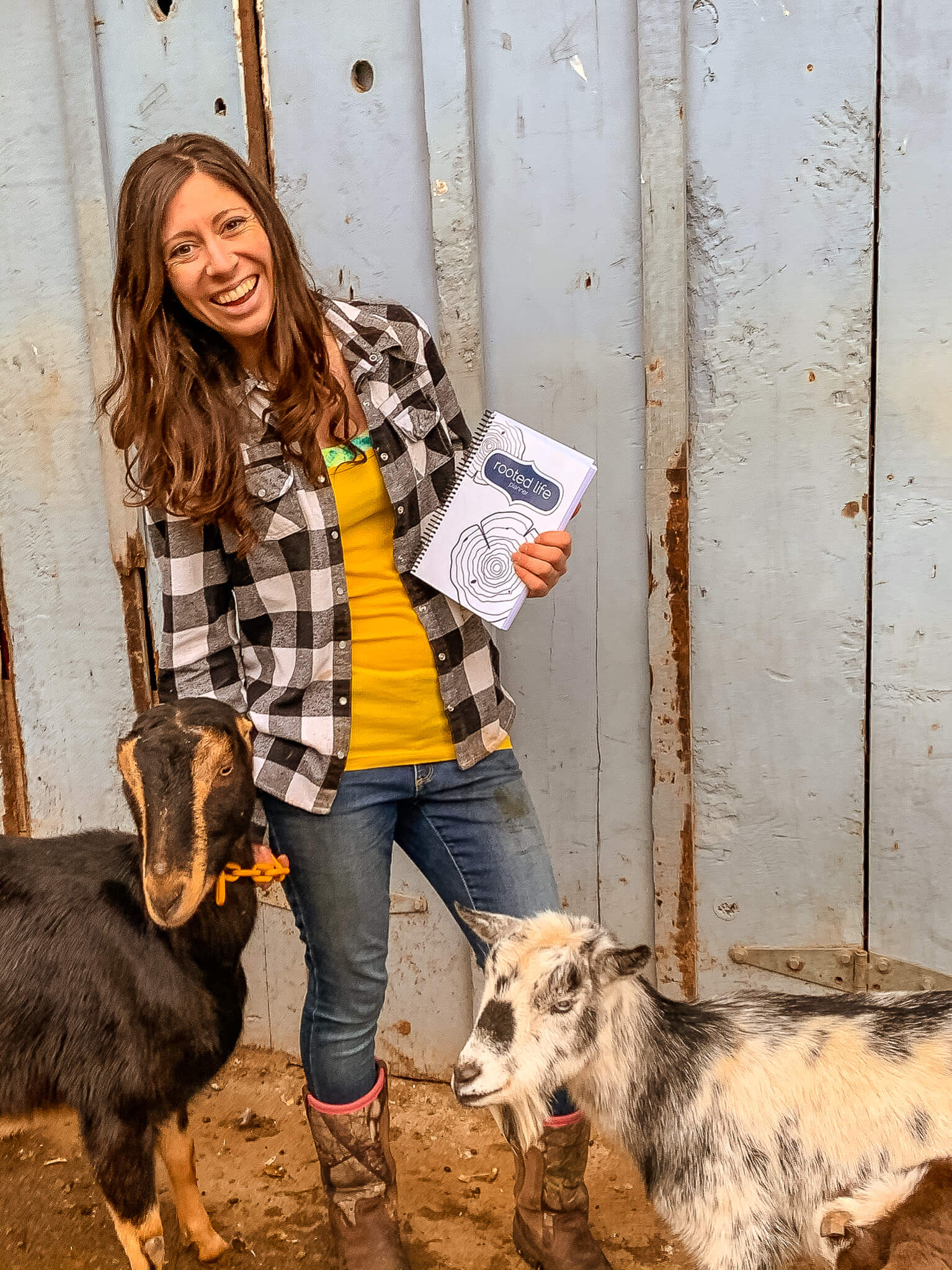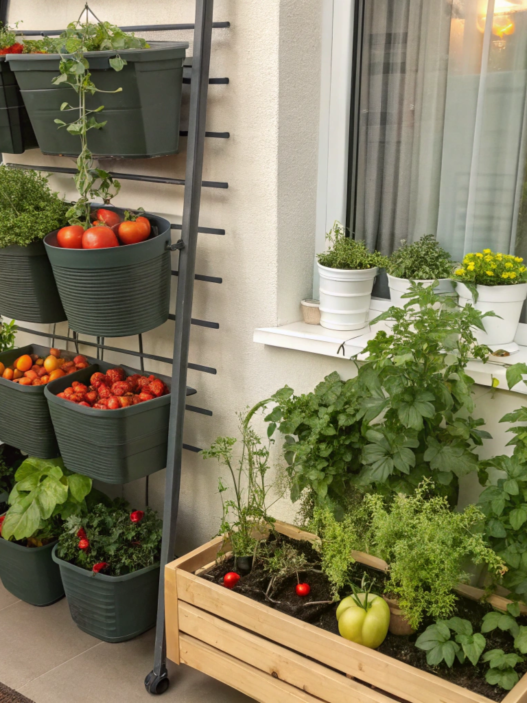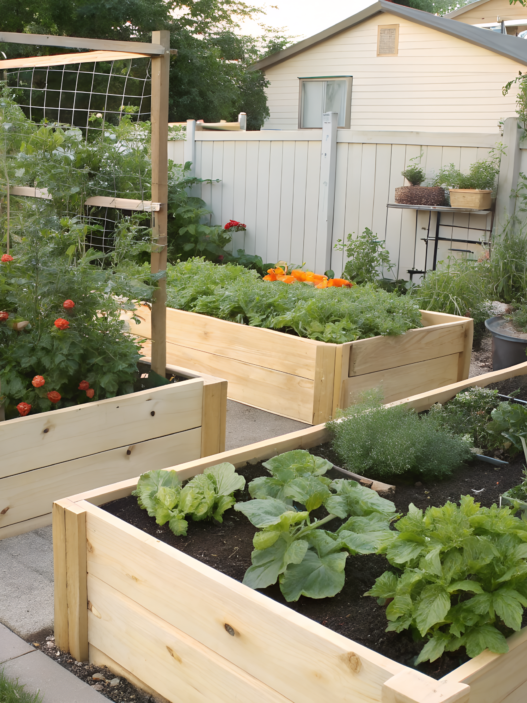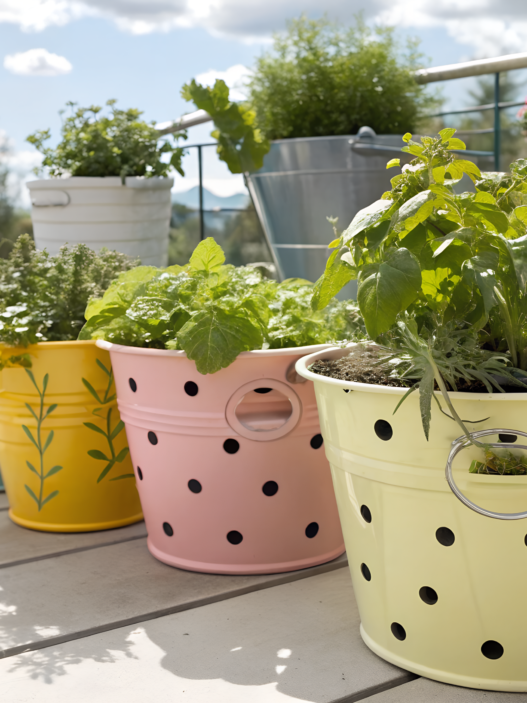What we already know a lot about companion planting is that it’s not just randomly placing plants next to each other in hopes of getting lucky. It’s about creating a living ecosystem where plants support each other, helping to accelerate growth, deter pests, and even enrich the soil, all without any chemicals.
And trust me, after years of experimentation (and lots of mistakes!), I’ve found strategies that truly work and that I hope will help you create a fertile garden, too.
Let’s get to it!
The Secret Trick to Growing the Sweetest Strawberries

One of the easiest and most effective ways to improve your strawberry crop is to plant borago (cucumber weed) nearby. This unpretentious plant performs several useful functions at once:
- Attracts pollinators. Bees and bumblebees are particularly fond of the blue flowers of borago. More pollinators means better berry setting.
- Repels pests. There is evidence that borago can repel aphids and some other pests, protecting strawberries.
- Improves soil composition. The deep roots of borago extract useful minerals from the lower layers of soil, which enrich the upper layer after the plant dies back.
- Self-sowing. Borago propagates on its own, so it does not need to be replanted every year. But be careful: if you don’t control the growth, it can sprawl too much.
Tip. Borago, of course, is not a magic remedy, but it helps to create more favorable conditions for strawberries. The main thing for the sweetness of berries – enough sun and the right watering regime. Borago does not directly make the berries sweeter, but it can improve their yields through better pollination.
How to Naturally Fertilize Your Soil Using Companion Plants
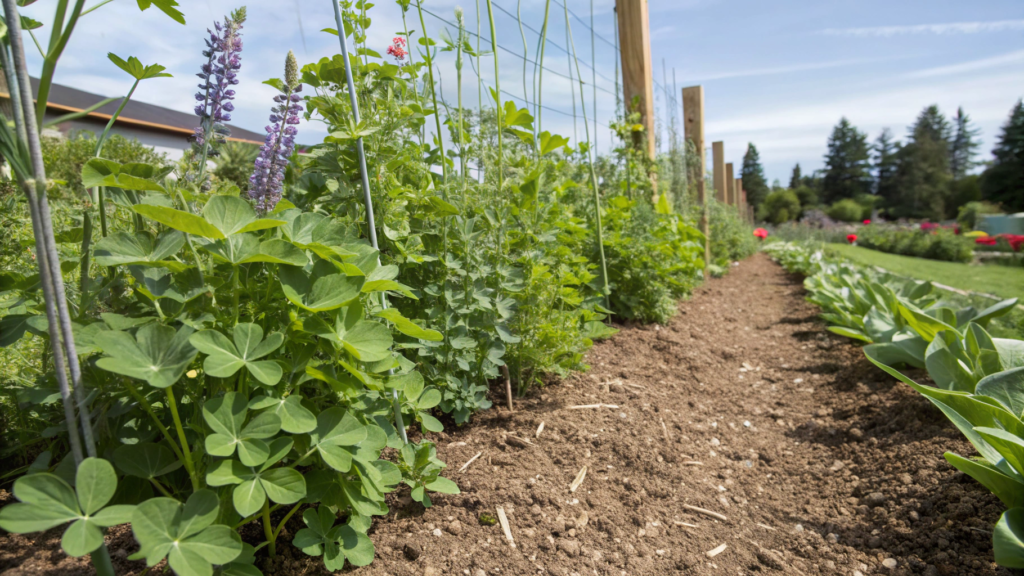
Nature has already taken care of us and devised the perfect system to improve soil fertility. Some plants have the ability to fix nitrogen, extracting it from the air and enriching the soil with it. This makes nitrogen available to other crops and promotes their healthy growth.
Here are some of the best nitrogen-fixing companion plants:
- Clover. A great living mulch that protects the soil from drying out and saturates it with nitrogen.
- Peas and beans. Classic nitrogen-fixing crops that improve the soil for cabbage and leafy vegetables.
- Lupines. Beautiful flowers with powerful roots that pull nutrients from deep within and loosen the soil.
Tip. If you want to improve the fertility of your beds without the hassle, try sowing clover or lupines between your main crops to improve soil structure and reduce the need for fertilizer.
Why Sunflowers Are the Best Companion Plant You’ve Never Tried

I adore sunflowers because they are not only a colorful ornament to the garden, but also an essential aid to the vegetable gardener. Their powerful stems, large flowers, and deep roots make them ideal neighbors for many crops.
- Attract beneficial insects. Bees, bumblebees and butterflies love sunflowers, which means neighboring plants get more pollination.
- Provide natural support. The tall stems of sunflowers provide natural support for climbing plants such as beans and cucumbers.
- Loosen the soil. Their strong roots improve soil structure, preventing soil compaction.
- Distract pests. Sunflowers can serve as trap plants, distracting aphids and other insects that would otherwise attack vegetables.
Tip. Don’t plant sunflowers too close to tomatoes and potatoes, as their root systems can compete for nutrients.
The Unexpected Flower That Supercharges Your Vegetable Garden

Some flowers in the garden do much more than just please the eye. You may be surprised, but one of the most useful companions for vegetable crops is the nasturtium.
- Repels pests. Nasturtiums release compounds that repel aphids and cabbage whiteflies.
- Attracts beneficial insects. Its brightly colored flowers attract bees and raiders that help with pollination and pest control.
- Prevents fungal diseases. There is evidence that nasturtiums can promote better air circulation in some cases, which indirectly reduces the risk of disease.
- Edible flowers and leaves. Not only is nasturtium useful for the garden, but it is also a great addition to salads with its slightly peppery flavor.
Tip. Plant nasturtiums next to tomatoes, cucumbers and cabbage as a trap plant – they will distract aphids and attract beneficial insects.
The Best Companion Plant for Tomatoes – It’s Not What You Think!
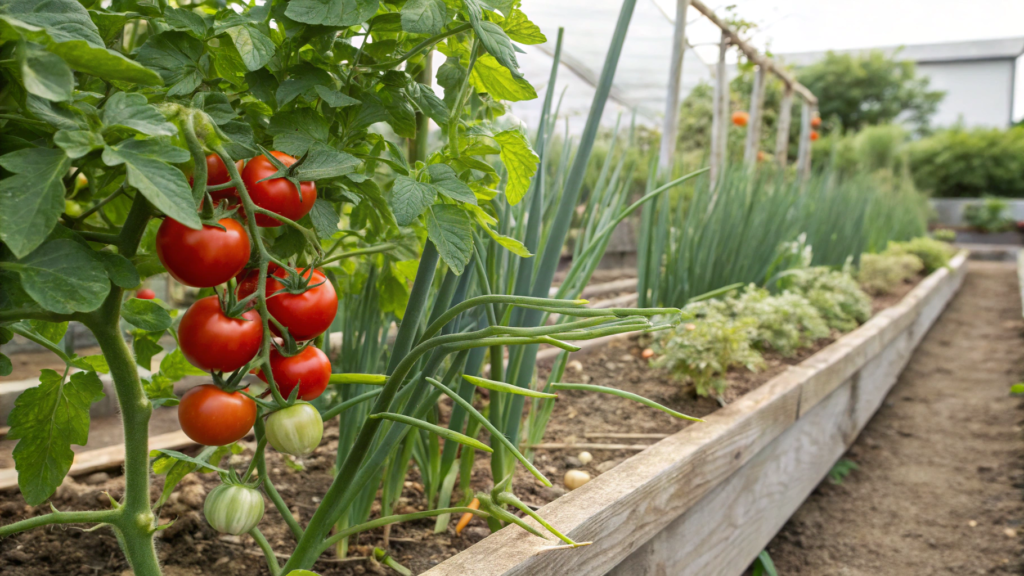
Most gardeners have heard that basil is a great neighbor for tomatoes, but there’s another plant that can give equally strong support – garlic.
- Repels pests. Garlic releases sulfur compounds that help protect tomatoes from aphids, spider mites and whiteflies.
- Reduces the risk of disease. Garlic’s phytoncides can prevent fungal infections (except for phytophthorosis, since this is a disease spread by spores in the air and soil, garlic cannot completely prevent it).
- Does not compete for food. Unlike some other companions, garlic doesn’t pull the same nutrients from the soil as tomatoes, which means they don’t interfere with each other’s growth.
- Compactness. Garlic does not shade tomatoes, it can be planted directly between the rows, saving space on the bed.
Tip. Plant garlic in the fall or early spring in between rows with tomatoes – it will help reduce the risk of infection with soil fungi and scare away some pests. However, additional measures such as good air circulation and soil tillage are needed to protect against phytophthorosis.
5 Companion Plants That Act as Natural Fertilizers
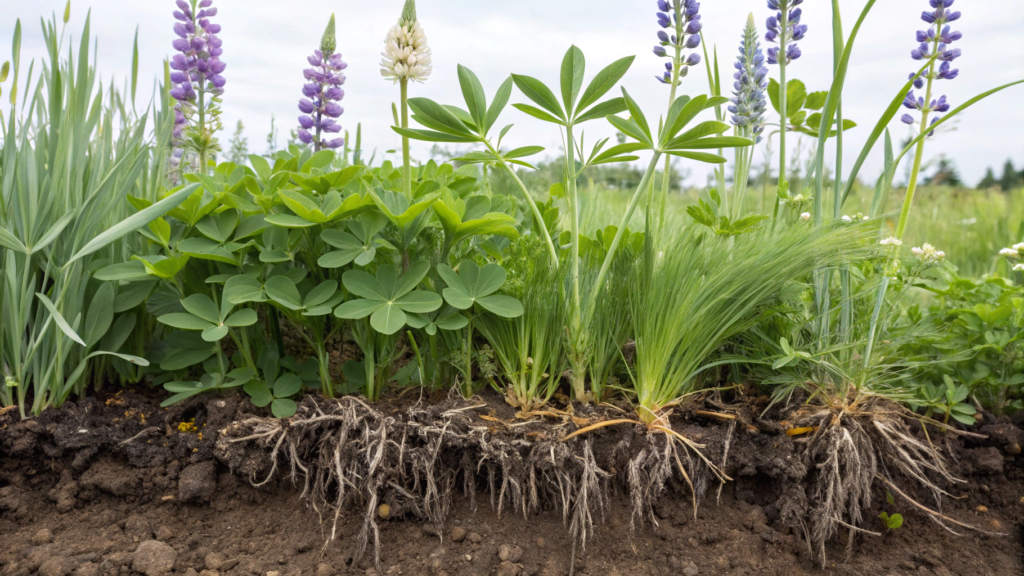
Some plants don’t just neighbor vegetables, they enrich the soil with nutrients to help other crops grow healthier and stronger. Here are five of the best natural fertilizers among companion plants:
- Clover. One of the best nitrogen-fixing plants. Its roots tie up atmospheric nitrogen and transfer it to the soil, making it available to other crops.
- Lupines. Like clover, lupines enrich the soil with nitrogen, but additionally loosen it with their powerful root system, which is useful for heavy soils.
- Oats. It is used as a siderate: after mowing its green mass decomposes and saturates the soil with potassium and phosphorus.
- Phacelia. In addition to improving soil structure, phacelia helps to reduce acidity and suppresses weed growth.
- Comfrey (viviparous). Its leaves contain a lot of potassium and phosphorus, so they are often used to prepare natural fertilizers (infusions or mulch).
Tip. These plants can be sown between main crops or used as a green fertilizer by burying them in the soil before planting vegetables.
Some plants complement each other perfectly, even if they seem incompatible at first glance. These unusual combinations not only improve crop growth, but also protect them from pests and diseases.
3 Unusual Companion Planting Combos That Will Shock You
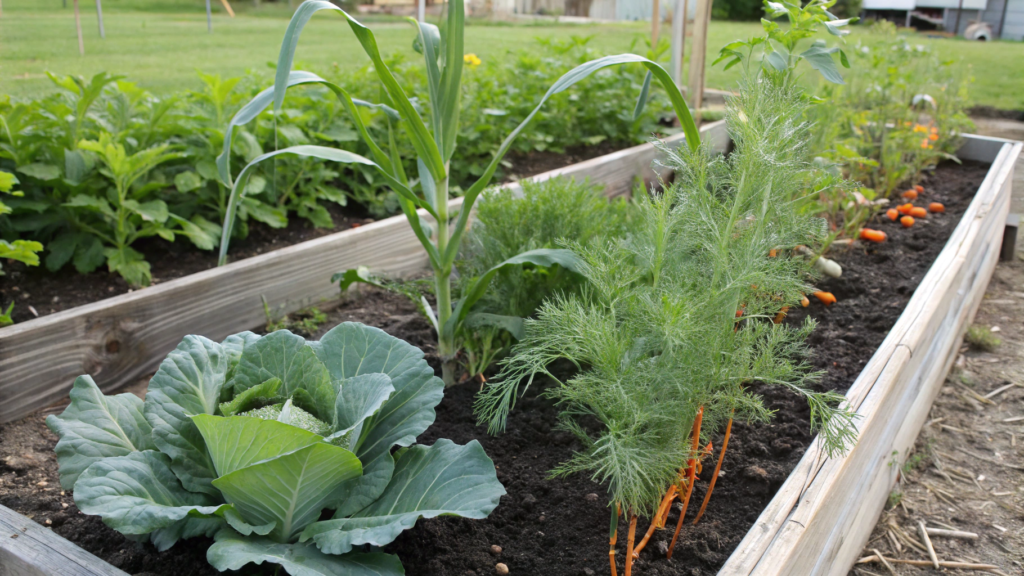
- Carrots + rosemary. Rosemary repels the carrot fly, which can destroy the entire crop. Rosemary’s fragrant essential oil confuses the pest, preventing it from finding carrots.
- Cabbage + dill. Dill attracts beneficial insects such as horseweed, which kill cabbage whitefly caterpillars, one of cabbage’s main enemies.
- Corn + beans. Beans fix nitrogen in the soil, enriching it for corn, and corn, in turn, serves as a natural support for curly bean stalks.
Tip. These combinations not only protect plants from pests, but also optimize bed space, allowing you to grow more crops in a smaller area.
4 Companion Planting Combos That Double Your Harvest

In companion planting, certain combinations help optimize space, improve soil nutrition and stimulate crop growth. Here are four science-based duos that will make your vegetable garden more productive.
1. Lettuce + radishes – a quick start for both crops
This combination is especially good for early spring planting:
- Radishes sprout faster, their root system loosens the soil, making it easier for the tender roots of lettuce to grow.
- Lettuce creates natural shade, preventing overheating and premature flowering of radishes (they go into arrow when hot).
- Both plants mature quickly, allowing you to reuse the bed during the season.
Tip. If you plant radishes at wider intervals, they will get bigger and the lettuce will occupy the gaps between the plants, keeping the soil from drying out.
2. Corn + beans – a classic of organic farming
This pairing uses the time-honored three sisters method (corn, beans, and pumpkin), but even without the pumpkin, the combination works perfectly:
- The corn serves as a natural support for curly bean stalks, saving space and eliminating the need for additional trellises.
- The beans fix nitrogen in the soil, providing natural fertilizer for the corn.
- Growing together helps conserve moisture in the soil as the dense foliage creates a favorable microclimate.
Tip. Use curly beans rather than bush beans – they will climb up the corn and won’t take up extra space in the bed.
3. Carrots + onions – a natural defense against pests
This is one of the most popular combinations, as the plants really protect each other:
- Onions repel the carrot fly thanks to their pungent odor, which prevents the insect from finding carrots.
- Carrots, in turn, can make onions more difficult for onion flies to detect, reducing the likelihood of bulb damage.
- Different root systems – carrots have deep tap roots and onions have shallow roots, so they don’t compete for food and moisture.
Tip. Alternate rows of carrots and onions rather than planting them intermixed – this way each crop will grow evenly.
4. Tomatoes + spinach – maximum benefits in one bed
Spinach is an excellent neighbor for tomatoes, especially in the early stages of growth:
- Spinach grows quickly and matures before the tomatoes begin to sprout without interfering with their development.
- Spinach’s broad leaves retain moisture in the soil, reducing the need for frequent watering.
- Spinach does not compete for light because it is low-growing and its roots do not interfere with tomato roots.
Tip. After harvesting spinach, its leaves can be used as mulch – they decompose, enriching the soil with useful substances.
How to Use Flowers in Companion Planting – The Best Pairings

Flowers in the vegetable garden are great helpers in controlling pests, improving pollination and even enriching the soil. Many of them can repel insects, attract beneficial pollinators and create a protective barrier for vegetable crops. Here are three of the best floral companions and their perfect pairs.
1. Nasturtium + tomatoes, cabbage, cucumbers – a natural shield against pests
Nasturtium is a versatile garden protector:
- Repels aphids, which is especially important for tomatoes and cucumbers.
- Attracts beneficial insects such as nasturtium riders, which kill pests.
- Works as a trap plant, diverting cabbage whitefly away from cabbage beds.
Tip. Plant nasturtiums around the edges of cabbage beds and next to tomatoes, but be aware that they can attract whitefly, so check the plants regularly.
2. Velvet + peppers, eggplants, potatoes – protection against nematodes
Velvet (tagetes) are known for their strong odor, which is not liked by many pests:
- Their roots release substances that suppress nematodes dangerous to root crops.
- Velvet flowers attract bees and other beneficial insects, improving crop pollination.
Tip. Plant velvets between rows of potatoes and peppers to reduce nematodes and attract pollinators.
3. Calendula + beans, carrots, lettuce – soft protection and soil improvement
Calendula is not only a medicinal plant, but also a great addition to the vegetable garden:
- Calendula repels nematodes and some soil pests.
- Attracts beneficial insects, especially bees and ladybugs, which helps with aphid control.
- Improve soil structure, and fallen calendula leaves decompose and enrich the soil with organic matter, it can be used as a mulch.
Tip. Plant calendula next to beans, carrots and lettuce – it does not shade low-growing crops, but creates a useful micro-environment.
3 Companion Planting Secrets That Make Pest Control Easy

Some plants emit repellent substances, others mask the odor of crops, and still others attract natural predators that eat pests. Here are three proven secrets to make your garden less vulnerable to insect pests.
1. Use “trap” plants – divert pests away from your main crops
Some plants work like live baits: they attract pests and distract them from valuable vegetable crops. This is especially useful if your garden is frequented by aphids or cabbage whitefly.
Best trap plants:
- Nasturtium – diverts aphids away from tomatoes, cabbage and cucumbers.
- Radishes – attracts fleas, saving cabbage and radishes. Cruciferous fleas prefer radishes, distracting them from other cruciferous plants (cabbage, radishes)
- Calendula – acts as a “magnet” for only some nematodes, keeping them away from root vegetables.
Tip. Plant trap plants around the perimeter of beds or between rows to protect main crops.
2. Confuse pests with strong smells – camouflage works!
Some insects search for their “victims” by smell, but if you have strong-smelling herbs and flowers growing near your vegetables, pests simply can’t detect them.
Best masking plants:
- Basil – confuses aphids and whiteflies if planted near tomatoes.
- Garlic and onions – mask the smell of carrots by protecting them from carrot fly.
Tip. Plant spicy herbs not only in separate beds, but also between vegetables so they create a protective barrier.
3. Attract natural predators – let insects do the work for you
Many beneficial insects prey on pests, but to attract them to the garden, they need the right conditions. The easiest way is to plant flowering plants that provide insects with food and shelter.
Which plants attract predators:
- Dill and fennel are favorite plants for raiders to kill aphids.
- Calendula and cosmea – attract ladybugs that eat spider mites and aphids.
- Phacelia – attracts lacewings whose larvae feed on caterpillars.
Tip. Leave some umbrella flowers and meadow grasses in the garden to keep beneficial insects in your vegetable garden longer. You can also add eschscholzia (California poppy), chamomile and yarrow to attract predators – they improve the population of beneficial insects.
The Best Plants to Pair with Tomatoes, Peppers, and Cucumbers

Some plants can improve the health, yield, and protection of tomatoes, peppers, and cucumbers when planted together. The right companions help repel pests and increase soil nutrition. Here are the best neighbors for these crops.
1. Best companions for tomatoes
- Basil – helps repel aphids, whiteflies and, according to many gardeners, improves the flavor of tomatoes.
- Garlic and onions – protect tomatoes from fungal diseases
- Velvet – their roots release substances that inhibit the development of nematodes, and the flowers repel aphids.
- Spinach and lettuce – protect the soil from overheating, retain moisture and do not interfere with the growth of tomatoes.
- Dill and fennel – attract beneficial insects such as horseflies and ladybugs.
Tip. Avoid neighboring tomatoes with potatoes and eggplants, as they are susceptible to the same diseases, including phytophthorosis.
2. Best companions for peppers
- Coriander and dill – attract horseflies, ladybugs and lacewings that feed on aphids.
- Basil – not only helps peppers grow stronger, but also improves their flavor.
- Beans – enrich the soil with nitrogen, making it more fertile for peppers.
- Spinach and chard – grow in the lower tier, protecting the soil from drying out.
Tip. Do not plant peppers next to fennel – it suppresses their growth.
3. Best companions for cucumbers
- Corn – serves as a natural support for braided cucumber stems.
- Nasturtium – repels aphids, which often infest cucumber beds.
- Beans and peas – can serve as natural supports and enrich the soil with nitrogen.
- Fennel and phacelia – attract pollinators, increasing yields
Tip. Do not plant cucumbers next to potatoes – they can transmit diseases such as phytophthora to each other.
5 Companion Planting Mistakes That Are Ruining Your Garden
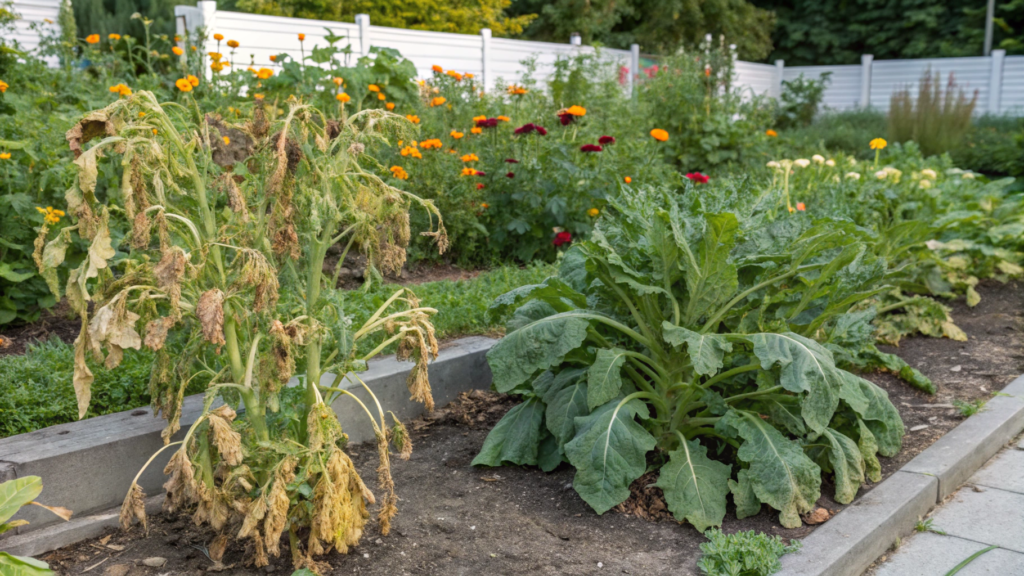
Even when you know the basic principles of companion planting, it’s easy to make mistakes that can reduce yields, lead to disease and even ruin the flavor of your fruit. Here are 5 of the most common mistakes to avoid.
Mistake № 1: Planting incompatible plants
Some crops compete with each other for resources or excrete substances that stunt the growth of their neighbors.
What not to plant together:
- Tomatoes and potatoes – susceptible to the same diseases (phytophthorosis).
- Beans and onions – onions can stunt the growth of legumes due to compounds released.
- Fennel and any vegetable crops – it suppresses the growth of most plants because of the compounds released.
Tip. Check plant compatibility before planting to avoid problems.
Mistake № 2: Ignoring plant height
Some tall crops can shade out low plants, preventing them from getting enough light.
What causes problems:
- Corn next to low-growing peppers or eggplant – the peppers don’t get enough sun.
- Sunflowers next to tomatoes – tomatoes may develop more slowly due to shade.
Tip. Plan your plantings so tall plants don’t shade out low plants.
Mistake № 3: Planting companions too densely
Even useful plants can interfere with each other if planted too densely. This reduces air circulation, creating the perfect environment for fungal diseases.
Where the mistake is most often made:
- Velveteen too tightly around tomatoes – can trap moisture and cause fungal infections if the bed is not well ventilated.
- Onions too close to cabbage – stunts its growth if you don’t leave enough space.
- Tomatoes and basil – if planted too densely, tomatoes can be poorly ventilated, increasing the risk of Phytophthora.
- Beet and carrots – both are deep-rooted crops so will compete for space if planted closely.
Tip. Leave enough distance between plants to avoid problems.
Mistake № 4: Improper use of trap plants
Some plants distract pests, but if you place them incorrectly, you can make things worse.
Where the most common mistake is:
- Nasturtium in the center of a vegetable bed – attracts aphids, but doesn’t divert them away from crops.
- Calendula in a cucumber bed – can attract too many nematodes if not controlled.
Tip. Place trap plants along the edges of the plot to keep pests from getting to the main crops.
Mistake № 5: Ignoring seasonal characteristics
Some plants work well at certain times of the year, but aren’t appropriate for the entire season.
Typical mistakes:
- Lettuce next to tomatoes in the summer – overgrows and starts to choke out the tomatoes.
- Dill next to peppers in the cool season – can grow too fast, choking out the peppers.
- Spinach and tomatoes – if left in the warm season, spinach will go into bloom and cease to be a useful companion.
- Cabbage and dill – if planted too late, dill can suppress cabbage.
Tip. Select companions based on seasonal conditions and crop growth rates. Early-ripening crops (lettuce, radishes, spinach) are best grown in the cool season. Slow-growing crops (peppers, tomatoes) should not compete with fast-growing herbs.
The #1 Rule of Companion Planting That No One Talks About

Companion planting is not just a set of rules from books. It works differently in every garden because soil, climate, and even pests are different in every region. That’s why the main rule that almost no one talks about is experiment and observe.
Why are there no universal solutions?
Many plant compatibility recommendations are based on general gardening experience, but they don’t always work in every case. Here’s why:
- Soil can vary. For example, beans enrich the soil with nitrogen, but if you already have fertile soil, the effect will be minimal.
- Climate affects plant growth. In hot regions, basil is great for protecting tomatoes, but in cooler climates it may grow too slowly with no noticeable effect.
- Some pests may not be found in your region. For example, planting nasturtiums for aphid protection only makes sense if you have a real aphid problem in your area.
Tip. Instead of blindly following schemes, observe your garden and make planting adjustments each season.
What’s the right way to experiment with companion planting?
- Record your observations. Keep a journal or take photos to keep track of what combinations work for you.
- Start with small tests. For example, try planting garlic between rows of tomatoes in one bed and no garlic in the other. That way you’ll see a real difference.
- Change the planting scheme every year. If one combination doesn’t work, try other companions.
- Pay attention to natural cues. For example, if cabbage doesn’t grow well next to fennel, it means they are actually suppressing each other.
A few unexpected facts that gardeners have discovered through experimentation
- In some cases, tomatoes are better off without basil. If the soil is too wet, basil can inhibit moisture evaporation, creating conditions for fungi.
- Onions don’t always interfere with beans. In warm climates, beans sometimes grow faster and have time to adapt to being next to onions.
- Velvet plants work against nematodes, but not immediately. Their roots release substances, but the effect is noticeable only after several seasons.
Tip. The best way to create the perfect garden is not to be afraid to try new things and adapt the principles of companion planting to your plot.
Plant wisely!
Experiment and observe! After all, the best plant combinations depend not only on theory, but also on the conditions of your garden. Apply the principles of companion planting, but don’t be afraid to try new combinations – nature will always tell you what works best!
What combinations have you already tried on your plot? Share them in the comments!
